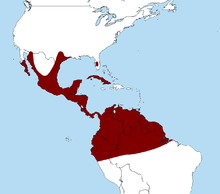

Northern crested caracara
| Northern caracara | |
|---|---|
| At Brevard Zoo, Florida | |
| Scientific classification | |
| Kingdom: | Animalia |
| Phylum: | Chordata |
| Class: | Aves |
| Order: | Falconiformes |
| Family: | Falconidae |
| Subfamily: | Polyborinae |
| Genus: | Caracara |
| Species: | C. cheriway |
| Binomial name | |
| Caracara cheriway (Jacquin, 1784) | |
 | |
| Range of C. cheriway | |
| Synonyms | |
Polyborus cheriway
Polyborus plancus Polyborus plancus cheriway Caracara plancus cheriway Polyborus plancus audubonii Polyborus tharus[2] | |
The northern crested caracara (Caracara cheriway), also called the northern caracara and crested caracara,[3] is a bird of prey in the family Falconidae. It was formerly considered conspecific with the southern caracara (C. plancus) and the extinct Guadalupe caracara (C. lutosa) as the "crested caracara". It has also been known as Audubon's caracara. As with its relatives, the northern caracara was formerly placed in the genus Polyborus. Unlike the Falco falcons in the same family, the caracaras are not fast-flying aerial hunters, but are rather sluggish and often scavengers.
Distribution[edit]
The northern caracara is a resident in Cuba, northern South America (south to northern Peru and northern Amazonian Brazil) and most of Central America and Mexico, just reaching the southernmost parts of the United States, including Florida, where it is resident but listed as threatened. There have been reports of the crested caracara as far north as San Francisco, California.[4] and, in 2012, near Crescent City, California.[5] In July 2016 a northern caracara was reported and photographed by numerous people in the upper peninsula of Michigan, just outside of Munising.[6][7][8] In June 2017, a crested caracara was sighted far north in St. George, New Brunswick, Canada.[9] South of the US border, it is generally common. It can also be found (nesting) in the Southern Caribbean (e.g. Aruba, Curaçao and Bonaire). This is a bird of open and semi-open country.
Habitat[edit]
Northern caracaras inhabit various types of open and semi-open country. They typically live in lowlands but can live to mid-elevation in the northern Andes. The species is most common in cattle ranches with scattered trees, shelterbelts and small woods, as long as there is a somewhat limited human presence. They can also be found in other varieties of agricultural land, as well as prairies, coastal woodlands (including mangroves), coconuts plantations, scrub along beach dunes and open uplands.
Behavior
The northern caracara is a carnivorous scavenger that mainly feeds on carrion. The live prey they do catch is usually immobile, injured, incapacitated or young. Prey species can include small mammals, amphibians, reptiles, fish, crabs, insects, their larvae, earthworms, shellfish and young birds. Bird species that are culled can range from large, colonial nesting birds such as storks and herons to small passerines. Reptiles taken often including snakes, lizards and small freshwater turtles. This species, along with other caracaras, is one of few raptors that hunts on foot, often turning over branches and cow dung to reach food. In addition to hunting its own food on the ground, the northern caracara will steal from other birds, including vultures, buteos, pelicans, ibises and spoonbills. Because they stay low to the ground even when flying, they often beat Cathartes vultures to carrion and can aggressively displace single vultures of most species from small carcasses. They will occasionally follow trains or automobiles to fetch food that falls off.[12]
Northern caracaras can usually be spotted either alone, in pairs or family parties of 3–5 birds. Occasionally roosts may contain more than a dozen caracaras and abundant food sources can cause more than 75 to gather. The nesting season is from December to May and is a bit earlier the closer the birds live to the tropics. They build large stick nests in trees such as mesquites and palms, cacti, or on the ground as a last resort.[13] The nests are bulky and untidy, 60–100 cm (24–39 in) wide and 15–40 cm (5.9–15.7 in) deep, often made of grasses, sticks and hay, spotted with much animal matter.[12] It lays 2 to 3 (rarely 1 to 4) pinkish-brown eggs with darker blotches, which are incubated for 28–32 days.[14]

No comments:
Post a Comment
Note: Only a member of this blog may post a comment.